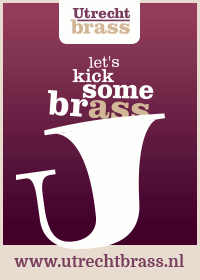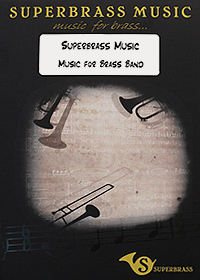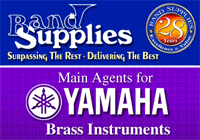Jubilee Brass - National Finals Gala Concert
24-Oct-2002Royal Albert Hall, London,
Saturday 19th October 2002
Bands:
International Staff Band, Stephen Cobb
Black Dyke, Nicholas Childs
Don Lusher Big Band, Don Lusher
Although the 'House Full' signs weren't displayed at the RAH on that Saturday evening there was a sizeable audience present to hear the concert.
The International Staff Band of the Salvation Army took the stage and as they were being the seated the lights of the auditorium dimmed. The video screen burst into life with footage of the firework and light show from the June Jubilee Celebrations over London and Buckingham Palace. A rather thin sounding recording of Handel's, 'Music from the Royal Fireworks' was used as accompaniment and it concluded with a football style, exited greeting "Welcome to the 2002 Jubilee Brass Concert" (or words to that effect). I assume it designed to get the audience applauding - they didn't but what they did do however was give the ISB Bandmaster Stephen Cobb a very warm reception as he came from the wings.
Flourish and Dances (Kevin Norbury)
Written for a Canadian Brass Band - Intrada Brass - this four-movement work opened the concert.
Flourish - A prelude to a courtly masque this piece opened with percussion and then in very controlled ceremonial style, the ISB confidently opened the concert.
Pavanne - Horns and Baritones featured together with Glockenspiel in a short slow dance. The Elizabethan style was nicely captured by the tom-tom in the fashion of a tabor which acted as accompaniment to the unfolding music.
Basse Dance - Played in lively style the ISB created a very effective feel to this movement.
Hornpipe - Best described a 'Rodeo' meets the 'White Heather Club' This lively dance opened with a distinctly American Square Dance structure which blended, as the music progressed, with the feel of a Scottish Reel. It ended with a tight and progressively faster tempo and was warmly applauded at its conclusion.
Shiela Tracy, the compere for the evening, introduced the next item that was written in 1993 and re-worked for this concert by the composer.
Music for a Joyful Occasion (Kenneth Downie)
Opening with glockenspiel the music went through a gradual crescendo to introduce the chorus 'Jesus I Love You'. A most lyrical section, which featured eloquent playing in a euphonium passage, was introduced to the music before a syncopated bass figure heralded a cornet and euphonium duet. A gentle statement very reminiscent of an Eric Ball test piece carried the music forward before agile playing of sparkling quality closed out the work. Musical figures featuring the whole band including highlights for the cornets, snare, tuned percussion over an intricate full band scoring before euphoniums and trombones were included then a final restatement by the cornets and coda.
Peter Graham composed, or scored, five of the items featured in this concert and was present in the audience to hear his music played. His scoring of the Hubert Parry hymn tune 'Repton' was the next item chosen by the ISB for this concert who played exceptionally well again.
Dear Lord and Father of Mankind (Parry arr. Peter Graham)
John Greenleaf Whittier's hymn in a three verse setting was due to be complimented with the text projected onto the multi-media screen but this did not happen rather it showed live pictures of the band playing which was the general order of the whole concert. The music opened with a cornet lead to a basic four-part harmony accompaniment. A simple two note rocking motif on glockenspiel linked the music to the next verse which featured the flugel and finally to a verse featuring the full band. The middle of the band took the melody whilst the cornets added flourishes to strong trombone accompaniment. Euphonium arpeggios led to a restatement by the flugel and cornet to a close using the glockenspiel two-note figure again.
The Last Amen (Peter Graham)
This music was specially commissioned for this concert by the ISB Bandmaster Stephen Cobb. It was a piece featuring contemporary songs of worship that were expertly arranged into a joyful musical montage. With attack, a rapid snare was joined along the way by muted trombones and cornets bringing the music together to a full band sound with a broad melody line. A most controlled crescendo and decrescendo led to a horn link then to feature the middle of the band. Cornet and flugel features brought the music round to a latinesque section featuring bongos and claves and the music captured the mood as the cornets, trombones and euphonium produced swinging sounds. A lovely controlled bridge brought round a quite silvery euphonium solo over suspended cymbal. With trombone underscoring and muted cornet sounds this section was wonderfully plotted by the composer and the ISB took the opportunity to sing at their very best. A mood change heralded by the bongo and kit pushed the music forward with light, happy sounds. A slapstick rhythm was taken up the players whose handclapping accompanied the cornets and trombones. The hand clapping complete the slapstick had its last few bars before the music slowed and the arrangement to a final direction building toward a full ensemble close.
The ISB deserved the lengthy applause they received for a first-rate performance.
In order to facilitate the stage setting the multi-media screen came to life again, this time with footage of Stephen Cobb and Nick Childs in conversation at the Royal Northern. Reflecting on last year's concert, the Heaton Collection CD collaboration and the respective movement National Youth Bands the concert moved forward as Black Dyke took the stage.
Opening with 'Summon the Dragon' this performance, although well played, wasn't quite as scintillating as this short fanfare and prelude had been at the British Open Concert.
As the applause settled the video screen filled with footage of Roger Webster explaining his reasoning for arranging and playing Mexican Hat Dance. With memories of cartoon imagery and a stunning interpretation once produced by the JSVB he took the stage to huge applause.
Following a drum announcement and a cornet statement the band introduced the first variation, a Latin rhythmic section. A simple 'da da da' declaration of the melody line with clear tone and sympathetic backing what followed was a clean double and then triple tongue variation. Interpolation of the Cossack Dance and a final post horn call brought this music to its conclusion in a bravura performance. The rousing reception and curtain call were well deserved.
Whilst Roger Webster was taking the applause Chris Turner had taken his place left and above the band in the choir stalls. He opened 'Cossack Fire Dance', the piece they played at the Bridgewater Hall Concert. It was played with far more precision on this occasion however I would have to say that the clapping at the Great Northern Concert was far more in time than that in the RAH. North 1 South 0 !
Philip Wilby, appearing on video, introduced the final item in the Black Dyke set 'The Finale from Symphony No 3 - The Organ Symphony'. He joined them in person on the RAH organ to also play this piece and his sumptuous organ pedals underpinned the spacious tutti articulation from the band. The expansive theme was played radiantly and with much energy from every section.
The second half of the concert was introduced on video by Don Lusher, who was quite humble in his comments when referring to his premiere of the Langford Trombone Rhapsody and his contact with bands movement.
Composed by Don Lusher himself 'DL Blues' has served him well and was used as a short signature tune to set the scene for the set of big band jazz.
'Love for Sale', music by Cole Porter opened the programme. With trombones playing over a swing cymbal the music made a feature of both a trombone and trumpet solo. The mood of the concert was changed absolutely. Mmmm Nice.
Henri Mancini wrote 'Dreamsville' and in keeping with the title the piano opened and the band played with brushed sounds with dominant saxophone scoring. Flugel featured before a simply stated sax solo to the final statement by piano. Mmmm Easy.
Introducing Tony Fisher to the stage he commenced the first of two arrangements showcasing his individual technique. 'Close Enough for Love'. In jazz-rock style the lower register of the trumpet gave way to an extended solo in freestyle in upper register. Mmmm Cool.
Maynard Ferguson had phenomenal range and iron lips but it his high-register work through which he essentially noted. Tony Fisher chose an arrangement of 'Sesame Street' and it is little surprise to learn that this featured high crushing notes. Jaaazz.
Don Lusher took the lead in a self-penned arrangement of 'Frankie and Johnny' which highlighted D.L.'s distinctive sound. Smooooth.
The final piece in this set was 'Mr. Anthony's Boogie' and in catchy style featuring all the different sections the band was in full flight. Mmmmm Nice.
Whether it would be every bandsman's cup of tea, I doubt. To feature this outfit in a 'traditional' band setting was a brave move and on a personal note I found the diversity a touch to far. The looser sounds, clipped notes and less precise note production were frustrating having listened to precision of the brass band playing. I personally prefer to listen to jazz in a relaxed and more ambient surrounding but then I don't write regularly for 'Jazz Monthly' do I. Mmmmm different.
With much scene shifting required Shiela Tracey scripted a kind of Don Lusher 'This is Your Life' She tried to make it sound spontaneous but failed as she painfully prompted him to speak of his life in music which he himself did really well.
Once the stage had been reset the massed bands of the ISB and Dyke were then ready to round out the concert with a showpiece set. 'Bravura Variations on British Sea Songs' arranged for euphoniums was another in the line of Peter Graham arrangements which had graced the concert. This was a staged showcase for the euphoniums David Childs, Derick Kane Steven Mead and David Thornton who received a massive round of applause. David Thornton and Derick Kane both wore their respective Black Dyke and ISB uniforms whilst Steven Mead wore a most vivid blue suit and David Childs sported a waistcoat which bore an 'in your face' image of a Welsh Dragon. In a piece featuring a number of traditional melodies, 'Oranges and Lemons', 'Men of Harlech' and the like, the soloist played off each other during a playful and humorous staging. In an unannounced, but very welcome diversion, Nick and Bob Childs joined the group after and off stage interruption. Their virtuoso duet performance of 'Flight of the Bumble Bee' filled the hall before the music concluded with all 6 euphoniums featuring in asextet playing 'Rule Britannia' with fair sprinkling of 'super' notes.
'1812 Overture' was played with stunning quality but it was the unscheduled cannon fire which had the audience in a state of shock; I'm sure the woman next to me had heart failure (I didn't fancy her so I just let her wheeze!) whilst it sent the rest of the audience burst into spontaneous babble.
If the cannon which went off early caused more stained undies than the first screening 'Exorcist' the fizzle and pop of the of some of the later cannons, which were real duffers, at least got tongues wagging after the concert.
An encore of 'I Vow To Thee My Country' played most eloquently rounded out the concert.
A embarrassing and uncoordinated exit (stage right) after the bands waited an inordinate length of time for Nick Childs to take a further curtain call (which in the end he didn't take) it was time to head off for a night cap or two. Mmmmm sweet beer!
Downsides to this concert, which overall didn't quite have the sparkle of the 2001 concert, were a programme that, for its price (£3), was very little more than a advertisement supplement and to reiterate our views from last year about the performance of Shiela Tracy which again was just poor and laboured.









